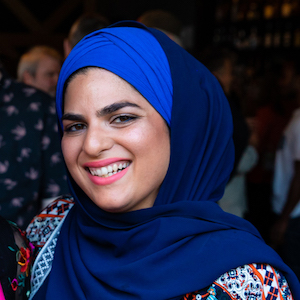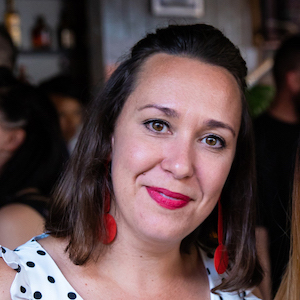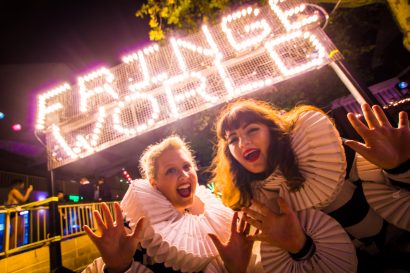It’s notoriously difficult to attract new audiences into our theatre spaces but it’s also absolutely vital if performing art-forms are to thrive in our increasingly digitalised world.
With its latest production, Layla Majnun, Performing Lines WA (PLWA) is leading the way in terms of diversifying audiences. Nina Levy caught up with PLWA’s Zainab Syed and Cecile Lucas to get the lowdown on the organisation’s exciting new approach to audience development.
Layla Majnun is one of the world’s oldest surviving stories.
And so, while it may be new to some sections of the WA community, for others it is an old friend.
It’s this mix of old and new that is one of the reasons Performing Lines WA (PLWA) has chosen to present a new translation of the classic Persian tale here in Perth, explains the organisation’s producer Zainab Syed. Directed by James Berlyn, this production of Layla Majnun, which will be presented at Subiaco Arts Centre from October 2-5, brings together emerging artists from diverse cultural backgrounds and pairs them with experienced local artists.

Likened to Romeo and Juliet, Layla Majnun was written by a poet called Nizami in the 12th century, and tells the story of two young people, Layla and Qays, who are from different Persian tribes. “They meet when they’re quite young and form a bond of friendship that then leads to love but for circumstances pertaining to tradition and family they aren’t ever together,” says Syed. “As Qays grows up, his love for Layla intensifies and he begins to be called Majnun which means madman… the story basically follows their life and how Majnun exiles himself into the desert. And eventually they both die which is not a spoiler… it’s just the Romeo and Juliet of the East.”
Though the story is Persian, it has been claimed by many different cultures, says Syed. “You’d be hard pressed to go to any Islamic country and find people who do not know about Layla Majnun… from Morocco to Turkey to Pakistan to Malaysia… each culture thinks that it’s theirs.”
It is the hope of the PLWA team that, by presenting a story so beloved by so many, they will draw new audiences to Subiaco Arts Centre and to the work of PLWA, whilst also exposing established theatre-goers to a new story.
As anyone who works in the arts knows, however, attracting new audiences is no mean feat. The story choice is just one of many strategies that the team is using to ensure that this production is attractive and accessible to members of Perth’s Muslim community who are not regular theatre attendees.
One of the big drawcards, in terms of attracting these new audience members, is that this translation of Layla Majnun is written and narrated by renowned US-based Farsi scholar and storyteller Ustaadh Feraidoon Mojadedi. His involvement in the work has created “quite a buzz in the Muslim world”, not just locally but internationally, says Syed. “When Usaadh Feraidoon came to Perth for the first creative development of Layla Majnun I was mindful that the Muslim community might feel that they needed to have access to him as well. So I held a storytelling night with him at Subiaco Arts Centre. I literally just put a quick event up on Eventbrite and shared it over email and on Facebook. Within a day it was sold out.
“On the night, Subiaco Arts Centre was full of such a diverse audience… 70 percent of those people had never been to Subiaco Arts Centre before.”
“On the night, Subiaco Arts Centre was full of such a diverse audience… 70 percent of those people had never been to Subiaco Arts Centre before.” Importantly, Syed emphasises, the bar was not open that night, out of respect for Muslim dietary laws.
Though the storytelling night was not related to Layla Majnun, it seeded an idea in Syed’s head about how she might promote the show. “When Ustaadh Feraidoon came back to Perth the following year for another development of the work, my brain started thinking a little bit more strategically than it had the first time. And so again I created an event. It sold out and then had to move to the main auditorium and that sold out as well. At that event I printed postcards that just said “Layla Majnun, coming soon” just kinda putting something in their brains.
One revelation, for Syed, was that she had drawn so many people to a venue they had never previously visited. “It wasn’t about the venue,” she observes. “It was about who you were putting in the venue and how you were making sure that the venue served their needs. So if I had the bar open the first time, a lot of those people would have been pretty uncomfortable to come back the second year.”

From here, Syed and PLWA marketing and project co-ordinator, Cecile Lucas, created focus groups within the Muslim community to find out more about why people might choose to go to a particular venue… or not. “When we mentioned that the bar would be closed, that we would have some prayer rooms, Halal food, music and entertainment, those things really resonated with them,” Lucas observes.
“When we mentioned that the bar would be closed, that we would have some prayer rooms, Halal food, music and entertainment, those things really resonated with them.”
Lucas has also been working to create a suite of activities that will run before the show to introduce audiences who aren’t familiar with Layla Majnun to the story. “We offer them different entry points to Layla Majnun. We’ve come up with five activities that will be held in a foyer before the show,” she elaborates. “Some activities are just fun and simple and some are a bit more profound. But I don’t want to say more because I want it to be a surprise.”
There will also be workshops based on Muslim culture on offer, she continues. “We’re having a calligraphy workshop and henna tattooing, both run by local Muslim artists. We’re also planning an exhibition with three local Muslim artists, Hadia Bangash, who is also Layla Majnun’s illustrator, Azadeh Yekta, who does Persian calligraphy art and Zara Azimi, who does Persian miniature paintings.
“So there is a full program of activities and entertainment before and after the show including music, food trucks with halal food, activities…”
It all sounds very enticing… and that’s the point. “We’re creating an experience and that experience doesn’t just start when you step inside the main auditorium but from the moment you enter the Subiaco Arts Centre.”
It all sounds very enticing… and that’s the point. “We’re creating an experience and that experience doesn’t just start when you step inside the main auditorium but from the moment you enter the Subiaco Arts Centre,” says Syed. “The feedback from our focus groups said that older uncles aren’t really interested in theatre shows. But if there’s other stuff going on that has more of a festival vibe they’re more likely to come together and that’s how can we incentivize whole families to come.
“And the other really real thing for me is that brown communities – and I can say this because I am a brown person from that community – we don’t keep time and everyone rocks up late and you know and if something starts at 7.30pm, everyone will show up at 8pm. But this is a theatre show and we have to start on time. So we’ve tried to find inventive ways of encouraging people to come early and one of them is having food and entertainment and activities beforehand.”
In addition to the focus groups, Lucas and Syed have also been liaising with Metropolitan Migrant Resources Centre, Ishar Multicultural Women’s Health Services and Association to Torture and Trauma Survivors to organise funding for 100 subsidised tickets for people from refugee and new migrant communities, for whom the cost of the ticket and logistics of transport might otherwise be a barrier to attendance. “We’re doing a matinee performance for them, providing them with buses and separate creche and Friday prayers afterwards,” says Syed. “It will be a relaxed performance, so people can come in and out, whereas the rest of the season is strict lockout. It’s about long-term thinking, about identifying groups who are not able to access theatre normally and working out how we can start to include them in in our art spaces.”
Listening to Syed and Lucas talk about the various ways in which they are reaching out to new audiences, it is clear that they are passionate about this work. What’s even more impressive is that Layla Majnun is just one example of the work that Performing Lines WA is doing to reflect the diversity of stories and experiences amongst artists and audiences in Australia. The organisation has a long history of working with Sensorium Theatre, who make works for children with disabilities. In November, PLWA will be presenting another cross-cultural work, Gui Shu, which sees WA director Sally Richardson working with artists from Taiwan and Australia.
“Through our work on Layla Majnun, and with artists like disability theatre-makers Sensorium Theatre and Sally Richardson’s upcoming intercultural work Gui Shu, we are making good on our promise to change what theatre and the audiences who attend it can look like,” remarks Syed.
And they’re showing that a small team can make a significant difference.
Layla Majnun plays Subiaco Arts Centre, October 2-5.
Learn about the design of ‘Layla Majnun’ below:
Like what you're reading? Support Seesaw.






